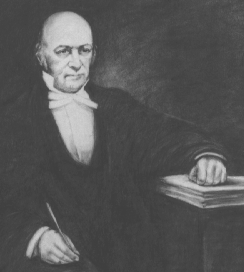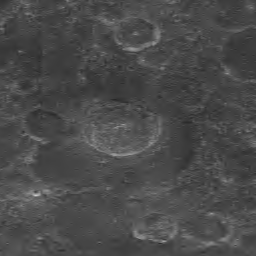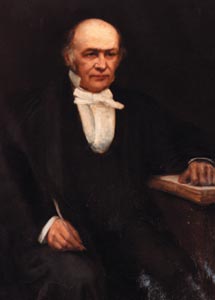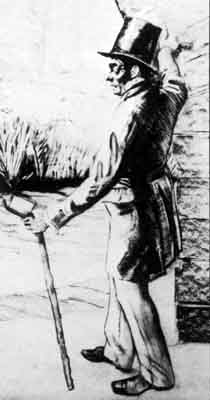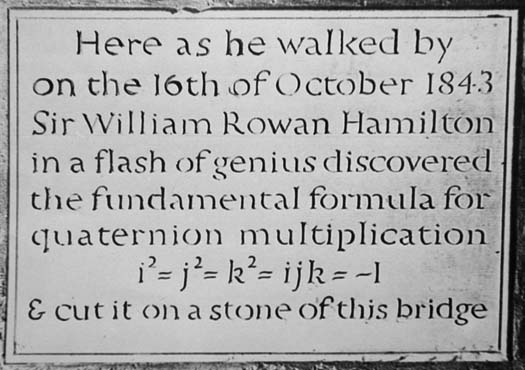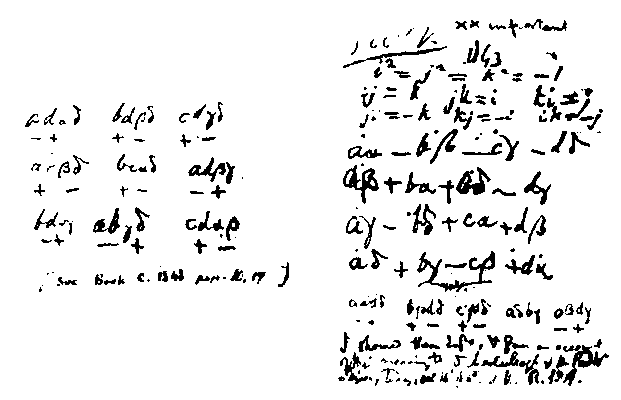Sir William Rowan Hamilton
1 Who was W.R. Hamilton?
An Irish mathematician.
2 When and where did he live?
He was born at 29 Dominick St., Dublin at midnight, 3rd August, 1805. He was sent to live with his uncle in Trim, Co. Meath at age 3. He got a job as an Astronomer and lived at Dunsink Observatory, Co. Dublin from 1827
until his death on 2nd Septemberin 1865.3 Why is this year so special? It is the bi-centenary celebration of his birth.
4 Why is 16 October so special?
It is the anniversary of his mathematical discovery at Broombridge, Cabra on 16 October 1843.
5 Why is Hamilton considered to be a genius? At age 5 he was fluent in Latin, Greek and Hebrew. At age 12 he was fluent also in French, Italian, Arabic, Syriac, Persian and Sanskrit. At age 13 he was a superb mathematical calculator although he lost in competition to an
American prodigy. At age 14 he invented a semaphore system of communication. At age 17 he entered Trinity College, Dublin obtaining 1st place in all examinations,
while some of his results (in both Science and Classics) were beyond classification in the
examination system (termed 'optime'). At age 22 he was appointed as a Professor of Astronomy – some time before he actually
graduated from the College.
At age 27 he used mathematics to predict the different paths taken by light as it passes
through certain objects. (Conical refraction in biaxial crystals). He also developed mathematics which allowed light to be treated as either a wave or a particle.
He was knighted three years later for his discoveries and received
a pension.
At age 30 he rewrote Newton's Laws of Motion.
At age 38 he discovered the Quaternions – a new mathematical system of numbers.
He is famous for formulating the laws of Physics in a special way and for developing
Hamiltonian circuits which are used in Graph Theory as well as his discovery of
Quaternions.
6 What was he like? He was a passionate romantic. He wrote volumes of poetry especially from the age of 14 after his father and mother had died. He felt responsible for his four sisters from that time. Later he provided a home for them
at Dunsink Observatory.
At age 19 he fell in love with a girl his own age, Catherine Disney. Unfortunately, she was matched with an older man of wealth and although she also loved him, she married
the older man. William fell into despair and felt his life was over. However, he threw himself into his studies and later, at age 27, married Helen Bayly from Nenagh, Co. Tipperary and they
had two sons and a daughter. His daughters' descendants (O'Regans) continue to live in England to this day. He was a religious man and became Churchwarden in the parish of Castleknock, Dublin
(Church of Ireland).
He was also passionate about mathematics and science. At age 22 he discussed the idea of beauty and aesthetics in mathematics with the poet
William Wordsworth who was aged 57 and led to Wordsworth changing his appreciation
of this subject. William Hamilton became a godfather to William Wordsworth's son, William, although later, he refused to become godfather to Oscar Wilde who by
coincidence, was born on the anniversary of Hamilton's quaternion discovery exactly 11 years previously. Sadly, throughout his life he was troubled by depression and excessive drinking of
alcohol. He died from complications of gout and bronchitis at age 60. He is buried in
Mount Jerome Cemetery in Dublin.
For his epitaph he wished to be remembered as a labour-loving and truth-loving man – the same epitaph which the ancient Ptolemy of Geeece gave to the astronomer
Hipparchus.
7 How is William Hamilton remembered?
In 1958 a commeration plaque was erected on Broombridge, Cabra by Taoiseach Eamon
deValera. The Hamilton building in Trinity College is named after him. A crater on the moon is named after him. The year 2005 is designated as Hamilton Year 2005 to celebrate the bi-centerary of his
birth. His ideas were developed in the theory of electromagnetism by Maxwell in 1873. His ideas also influenced the development of quantum mechanics and the design of
optical instruments. This work continues in the search for a Unified Field Theory which attempts to link the four principal forces which form the universe. Hamilton's mathematical ideas are finding practical application in the realm of computer
graphics for the manipulation of 3-dimensional shapes.
He invented the Icosian Game
Here is a link to a diagram of the Semaphore System
The annual Hamilton Walk from Dunsink Observatory to Broombridge, Dublin, on 16th
October, organised by The Mathematics Department of NUI, Maynooth. Here are some pictures from the 2005 Walk.
Sources: Riocht na Midhe, Records of Meath Archaeological and Historical Society, Vol.
XI, 2000
www.hamilton2005.ie ; http://hamilton.dit.ie/index.html ;
http://physicsweb.org/articles/world/18/8/7 ;
http://www-groups.dcs.st-and.ac.uk/~history ; www.cmf.nrl.navy.mil/clementine/ ;
http://understandingscience.ucc.ie/pages/sci_williamrowanhamilton.htm
http://www.maths.may.ie/links/hamilton.htm ; http://www.hamilton.tcd.ie/
http://www.maths.tcd.ie/pub/HistMath/People/Hamilton/
http://www.astronomy.ie/lecture0501.html
http://www.puzzlemuseum.com/month/picm02/200207icosian.htm
http://www.daviddarling.info/encyclopedia/I/Icosian_Game.html
This portrait of William Rowan Hamilton hangs in the Royal Irish Academy. Image: Royal Irish Academy.
This is a picture of the Hamilton Crater on the Moon
Sir William Rowan Hamilton and one of his sons (circa 1845) (Portrait of Hamilton from Enterprise Ireland Portrait Gallery, courtesy of Enterprise Ireland)
An engraving (Picture from the St. Andrew’s, Scotland, web-site).
William Rowan Hamilton
lived from 1805 to 1865 (Picture from the St. Andrew’s, Scotland, web-site)
(Picture from the St. Andrew’s, Scotland, web-site)
A page from Hamilton's notebook(Picture from the St. Andrew’s, Scotland, web-site)
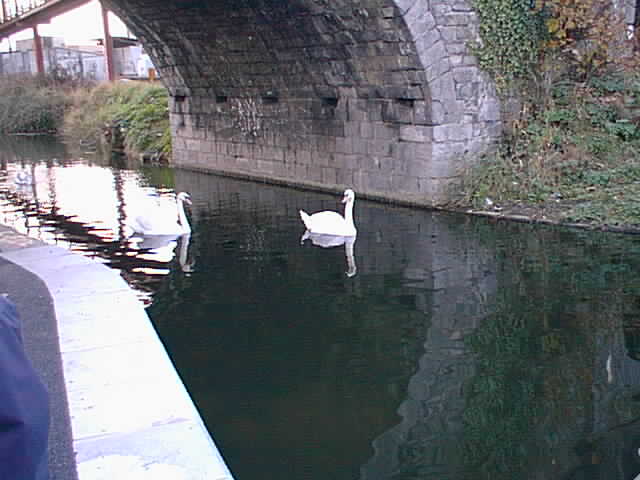
Broombridge, Dublin
Page created by Neil Hallinan 2005
